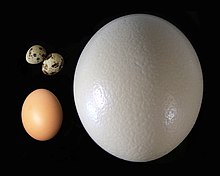
Back Eier (biologie) Afrikaans Ei ALS Uevo AN Æg ANG بيضة (أحياء) Arabic بيضه ARZ Güevu (bioloxía) AST Wow ATJ K'awna Aymara Yumurta (anatomiya) Azerbaijani

An egg results from fertilization of an ovum. The egg is a container for the zygote. It protects the zygote, and feeds the embryo.
The animal embryo develops until it can survive on its own, at which point the egg hatches. Most vertebrates, arthropods and molluscs lay eggs outside the mother's body. They are always in some kind of container, a shell or covering.
Reptiles, birds and monotremes lay cleidoic eggs: bird eggs are an example. These are a special kind of egg with a good supply of food and water. They have an outside covering which lets through gases so that carbon dioxide can get out, and oxygen can get in.
Fish, amphibia, insects and arachnids lay simpler eggs in greater numbers, but with much less protection and nourishment.